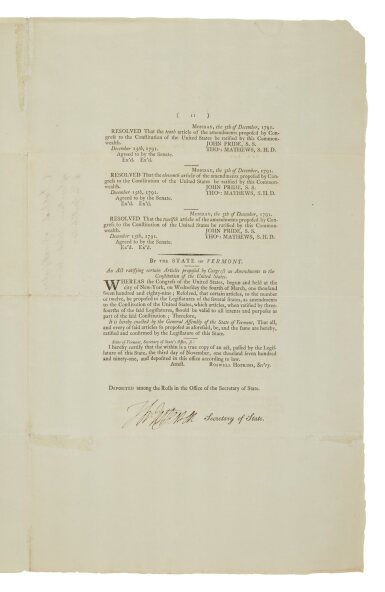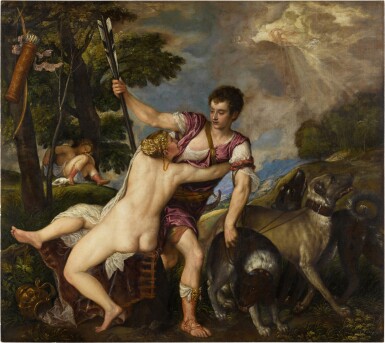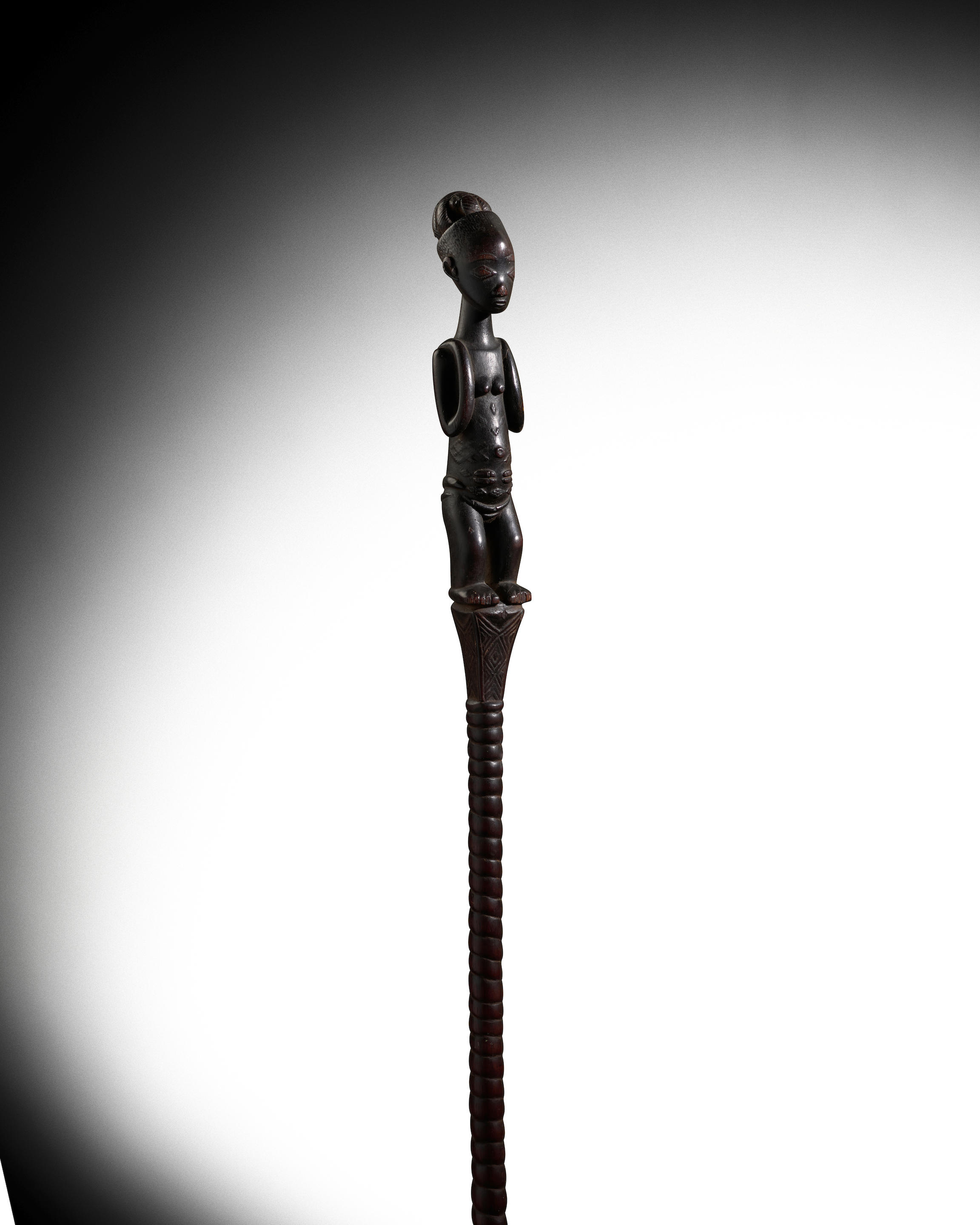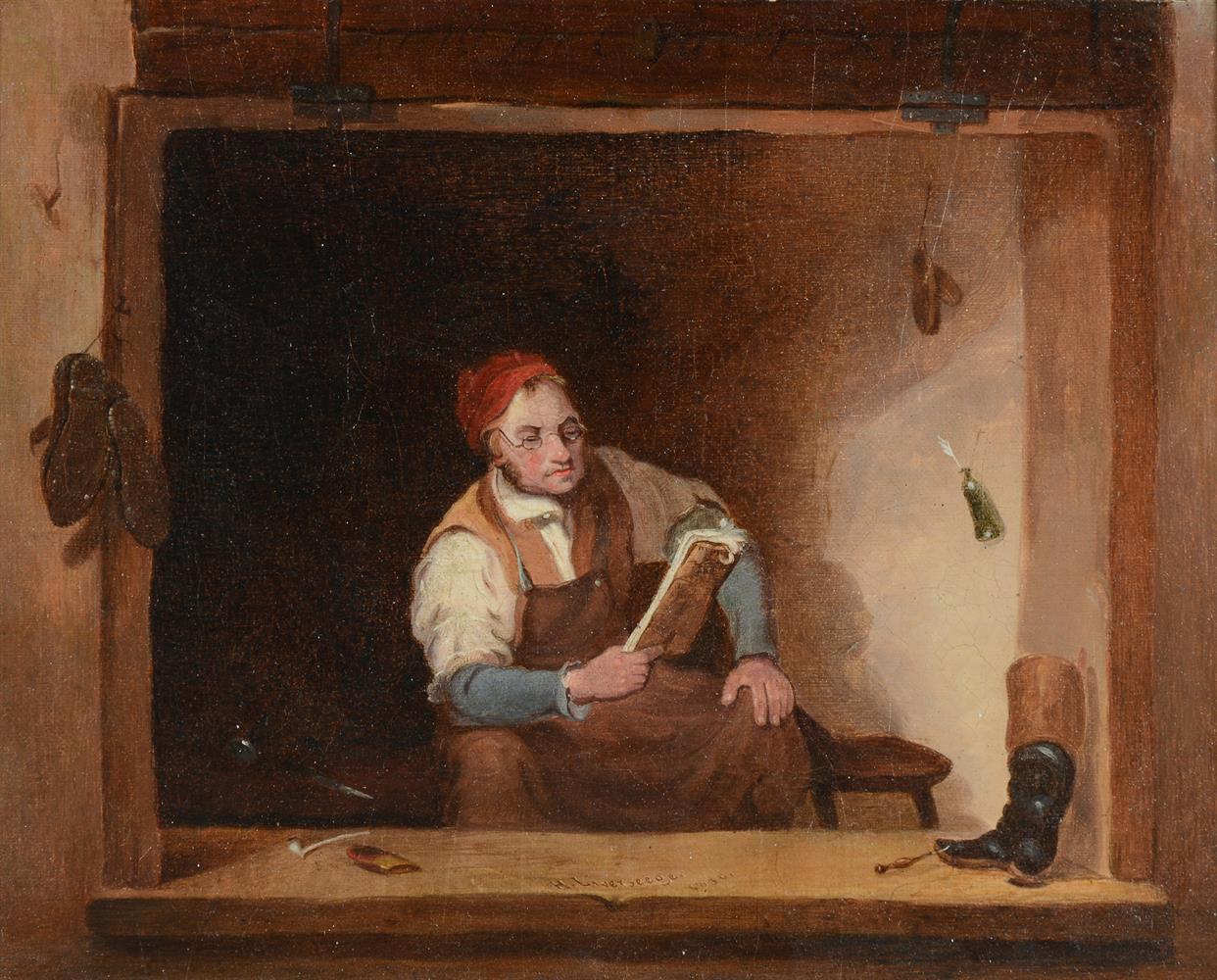THE INSTITUTION OF THE EUCHARIST, miniature by Simon Bening illuminated manuscript on vellum [Bruges, 1530s] An expressive miniature by Simon Bening demonstrating his mastery of dramatic narrative and devotional intensity. 91 X 145mm, glued to card (two small holes by upper fictive frame, near slight wrinkling with consequent paint loss, small paint losses, darkened later varnish). Provenance : Sotheby’s, 12 December 1967, lot 8. At the Last Supper, Christ is blessing the bread, in the form of a communion wafer, and wine, in a chalice shaped cup, flanked by John and Peter. To the left is a prior scene in the Passion narrative, the Washing of Feet, to the right, a subsequent event, the Agony in the Garden, both scenes viewed through windows, over which the panelling projects. The complete lower fictive frame extends beyond the vertical framing to form a definite termination, unlike the incomplete upper frame, which has been cut through, presumably to leave some lower framing with an element placed above. The layout could have approximated that of the smaller, dismembered Enriquez de Ribera Prayerbook, probably of c.1525-1530. The leaf now in Cleveland Ohio has two miniatures, one above the other: Christ giving Judas the sop, Bening’s usual Last Supper scene, and Judas’s abrupt departure (The Cleveland Museum of Art, 2002.52, 170 x 125mm trimmed to the edge of the borders). If the present miniature had borders, its original leaf would have been at least 200-210mm wide, although Bening also painted miniatures without borders in which case the margins could have been smaller. It is possible that a leaf on this scale was always an independent sheet, conceivably part of a larger narrative series like Bening’s 64 small miniatures, each 68 x 52mm, perhaps of c.1530, mounted since the 19th century as a quadriptych (the famous Stein Quadriptych, Baltimore, Walters Art Museum, W.441). Given the continuing value placed on Bening’s work and its lasting appeal to collectors, it may be significant that the present miniature has yet to be associated with any others. The subject, apparently unusual for Bening, is very suitable for an altar card, a sheet for display on the altar with the essential texts of the mass. Vulnerable to damage, few such cards survive from this period. Among the earliest known are two vellum leaves, mounted on card, c.380 x 265mm, from a French set of three of c.1520, each with framed text above a miniature, in the Morgan Library and Museum, New York (M.1147) and the Free Library, Philadelphia (Lewis E M 43:21). The present miniature could likewise have been surmounted by text rather than an image and come from the central card of a set of three with the Consecration prayers. Although such sets became obligatory, earlier practice may have been more diverse. Along with purely pictorial sheets, a variety of texts was illuminated and illustrated for display in churches or secular settings. The present miniature is typical of the work of Simon Bening (1483/84-1561), born in Ghent and active in Bruges by 1500, who built up a European clientele for his exquisite illuminations that acquired a new value as handmade luxuries in the age of printing. As summed up by Thomas Kren, ‘the art of no other Flemish illuminator so fully epitomizes the triumph of Flemish miniature painting in Europe and its enduring eminence as a court art’ ( Illuminating the Renaissance , 2003, p.447; for Bening pp.447-486). His documented or signed miniatures form a secure basis for further attributions but differences in scale and intent make chronological certainty impossible, especially since Bening, like many great artists, frequently reworked earlier compositions in his search for perfection. Closest compositionally to the present miniature are the Cleveland scenes, with full-length figures; the immediacy of the half-length ‘close up’ view is parallelled in the equivalent scene in the Stein Quadriptych, also of Judas receiving the sop. The
THE INSTITUTION OF THE EUCHARIST, miniature by Simon Bening illuminated manuscript on vellum [Bruges, 1530s] An expressive miniature by Simon Bening demonstrating his mastery of dramatic narrative and devotional intensity. 91 X 145mm, glued to card (two small holes by upper fictive frame, near slight wrinkling with consequent paint loss, small paint losses, darkened later varnish). Provenance : Sotheby’s, 12 December 1967, lot 8. At the Last Supper, Christ is blessing the bread, in the form of a communion wafer, and wine, in a chalice shaped cup, flanked by John and Peter. To the left is a prior scene in the Passion narrative, the Washing of Feet, to the right, a subsequent event, the Agony in the Garden, both scenes viewed through windows, over which the panelling projects. The complete lower fictive frame extends beyond the vertical framing to form a definite termination, unlike the incomplete upper frame, which has been cut through, presumably to leave some lower framing with an element placed above. The layout could have approximated that of the smaller, dismembered Enriquez de Ribera Prayerbook, probably of c.1525-1530. The leaf now in Cleveland Ohio has two miniatures, one above the other: Christ giving Judas the sop, Bening’s usual Last Supper scene, and Judas’s abrupt departure (The Cleveland Museum of Art, 2002.52, 170 x 125mm trimmed to the edge of the borders). If the present miniature had borders, its original leaf would have been at least 200-210mm wide, although Bening also painted miniatures without borders in which case the margins could have been smaller. It is possible that a leaf on this scale was always an independent sheet, conceivably part of a larger narrative series like Bening’s 64 small miniatures, each 68 x 52mm, perhaps of c.1530, mounted since the 19th century as a quadriptych (the famous Stein Quadriptych, Baltimore, Walters Art Museum, W.441). Given the continuing value placed on Bening’s work and its lasting appeal to collectors, it may be significant that the present miniature has yet to be associated with any others. The subject, apparently unusual for Bening, is very suitable for an altar card, a sheet for display on the altar with the essential texts of the mass. Vulnerable to damage, few such cards survive from this period. Among the earliest known are two vellum leaves, mounted on card, c.380 x 265mm, from a French set of three of c.1520, each with framed text above a miniature, in the Morgan Library and Museum, New York (M.1147) and the Free Library, Philadelphia (Lewis E M 43:21). The present miniature could likewise have been surmounted by text rather than an image and come from the central card of a set of three with the Consecration prayers. Although such sets became obligatory, earlier practice may have been more diverse. Along with purely pictorial sheets, a variety of texts was illuminated and illustrated for display in churches or secular settings. The present miniature is typical of the work of Simon Bening (1483/84-1561), born in Ghent and active in Bruges by 1500, who built up a European clientele for his exquisite illuminations that acquired a new value as handmade luxuries in the age of printing. As summed up by Thomas Kren, ‘the art of no other Flemish illuminator so fully epitomizes the triumph of Flemish miniature painting in Europe and its enduring eminence as a court art’ ( Illuminating the Renaissance , 2003, p.447; for Bening pp.447-486). His documented or signed miniatures form a secure basis for further attributions but differences in scale and intent make chronological certainty impossible, especially since Bening, like many great artists, frequently reworked earlier compositions in his search for perfection. Closest compositionally to the present miniature are the Cleveland scenes, with full-length figures; the immediacy of the half-length ‘close up’ view is parallelled in the equivalent scene in the Stein Quadriptych, also of Judas receiving the sop. The















Try LotSearch and its premium features for 7 days - without any costs!
Be notified automatically about new items in upcoming auctions.
Create an alert